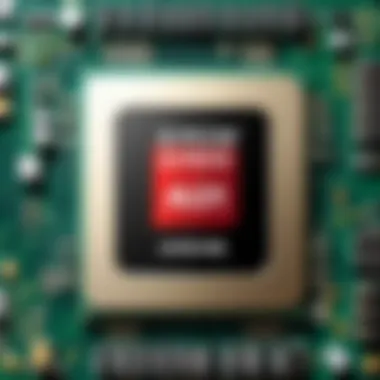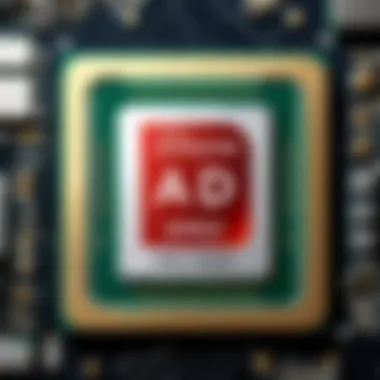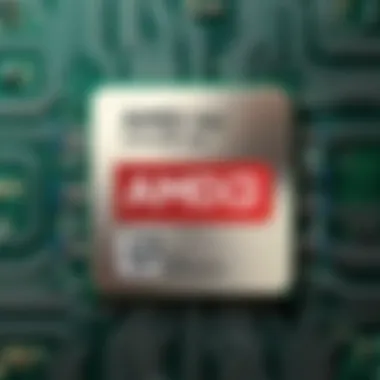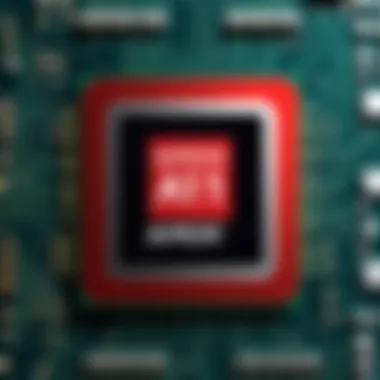In-Depth Look at the AMD A10 7850K APU Performance


Intro
The AMD A10 7850K is a notable component in the realm of accelerated processing units (APUs). This product presents a blend of CPU and GPU capabilities within a single unit. Its design has garnered attention for various computing tasks, from basic operations to more demanding applications like gaming. This section introduces the key facets and importance of the AMD A10 7850K in today’s computing landscape.
Product Overview
Key Features
The AMD A10 7850K inherits several key features that make it appealing to users:
- Integrated Graphics: It features AMD's Radeon R7 graphics, enabling better visual performance without requiring a dedicated GPU.
- Kaveri Architecture: Built on the Steamroller microarchitecture, providing improved efficiency.
- Socket FM2+ Compatibility: Ensures versatility for users looking to upgrade their systems without replacing the motherboard.
- Dual Graphics Support: Users can combine the APU with a discrete Radeon GPU for enhanced graphical performance.
Technical Specifications
The technical specifications of the AMD A10 7850K include:
- Base Clock Speed: 3.7 GHz
- Turbo Clock Speed: Up to 4.0 GHz
- Core Count: 4 cores
- Graphics Core Count: 512 stream processors
- TDP: 95W
These specifications display its focus on balancing processing capacity and energy efficiency for diverse computational scenarios.
Pricing Information
As of October 2023, the AMD A10 7850K is competitively priced, making it accessible for both casual users and tech enthusiasts. Prices typically range from $80 to $120, depending on the retailer or available promotions. This pricing strategy positions it well in the market, where users seek value alongside performance.
Performance Analysis
Benchmark Results
When tested under various benchmark scenarios, the AMD A10 7850K shows its capabilities:
- In CPU-heavy tasks, it performs admirably, often ranking close to its contemporaries.
- In graphical benchmarks, the integrated Radeon R7 GPU offers decent frame rates in many modern games.
- Overall, it typically achieves scores that reflect its mid-range status in the APU spectrum.
Real-World Use Cases
Real-world applications of the A10 7850K reveal its versatility:
- Gaming: Suitable for casual gamers who play titles like League of Legends or Dota 2.
- Content Creation: Adequate for tasks like video editing or graphic design, especially with the GPU offloading some processing.
- Office Work: Provides reliable performance for standard productivity software and multitasking.
Comparison with Competitors
When compared to similar APUs, the AMD A10 7850K stands its ground:
- Intel Core i3: Offers better single-threaded performance but lacks integrated graphics strength.
- AMD A8 Series: Directly competes but often produces lower graphical output, making the A10 preferable for media tasks.
Installation and Setup
Required Tools and Components
To set up the AMD A10 7850K, ensure you have:
- Compatible FM2+ motherboard.
- Adequate cooling solution.
- RAM, preferably dual-channel configuration.
- Power supply meeting the APU's requirements.
Step-by-Step Installation Guide
- Prepare the Workspace: Clear an area to work safely.
- Install CPU: Align the A10 7850K with the socket and lock it in place.
- Apply Thermal Paste: Even a small amount is sufficient for effective heat dissipation.
- Attach Cooling Unit: Secure the cooling solution on the CPU.
- Insert RAM and Power Supply: Install the RAM sticks and connect power cables.
- Boot Up: Power on the unit and enter BIOS settings to ensure proper recognition of all components.
Troubleshooting Common Issues
If you encounter issues:
- Check connections if the system does not boot.
- Ensure PSU compatibility with the setup.
- Ensure RAM is seated properly.
Pros and Cons
Advantages of the Product
- Cost-Effectiveness: Combines CPU and GPU functionality, reducing overall build costs.
- Decent Performance for Basic Tasks: Suitable for everyday computation and gaming.
Disadvantages or Limitations
- Limited Performance for High-End Gaming: More demanding games may not run smoothly.
- Heat Output: Requires adequate cooling solutions to maintain optimum performance.
Who It’s Best Suited For


The A10 7850K is ideal for:
- Casual gamers looking for budget options.
- Users needing a solid CPU-GPU combination for general tasks.
Final Thoughts
Summary of Key Points
The AMD A10 7850K APU is a valuable asset for those seeking to balance performance with cost. Its amalgamation of CPU and GPU functionalities allows it to cater to various computational needs without the necessity of high-priced components.
Recommendations for Potential Buyers
For individuals focusing on moderate gaming and essential computing tasks, this APU remains a strong candidate. Ensure it meets your specific needs before purchasing, particularly in terms of expected performance for gaming or productivity.
Future of the Technology or Product Line
As technology advances, the role of APUs like the A10 7850K may evolve, with newer models providing enhanced capabilities and efficiency. Staying informed about emerging CPU and GPU technologies will be vital for consumers looking to upgrade their systems in the future.
Prologue to AMD A10 7850K
The AMD A10 7850K APU is significant in the realm of computing due to its blend of processing power and integrated graphics capabilities. This APU is recognized for its versatility, catering to various computing needs. Understanding this component's design and benefits is crucial for informed decision-making, especially for tech enthusiasts and gamers looking for robust performance without the complexities of discrete graphics solutions.
Overview of APU Technology
An APU, or Accelerated Processing Unit, integrates the CPU and GPU onto a single chip. This design allows for efficient performance, especially in tasks that require both processing power and graphics rendering. The AMD A10 7850K exemplifies this trend. It offers a unique architecture that balances general computing tasks and graphics-driven applications. By consolidating processing capabilities, APUs often reduce power consumption and physical space requirements in systems.
The A10 7850K features four compute units, which enable multitasking and enhance performance in applications that can leverage the integrated graphics. As modern software increasingly demands both processing and graphical prowess, the significance of APU technology continues to grow. The A10 7850K provides a practical solution for users seeking an all-in-one solution, especially in compact form factors.
Market Position and Relevance
The A10 7850K holds an important position in the market. Launched during a period that saw rapid advancements in CPU and GPU technologies, it aimed to fill the gap for users who needed capable performance for everyday tasks and light gaming. Its relevance is marked not only by its specifications but also by its affordability compared to discrete graphics cards and higher-end CPUs.
This APU supports a wide array of applications, from basic computing tasks to gaming at moderate settings. For entry-level gamers or users focused on multimedia consumption, the A10 7850K offers a well-rounded experience. Additionally, with the rise in popularity of integrated solutions in laptops and small form-factor PCs, the demand for versatile and efficient APUs, like the A10 7850K, has increased.
Technical Specifications
The technical specifications of the AMD A10 7850K are crucial for understanding its capabilities and potential applications. They not only reflect the processing power and graphics prowess but also indicate how well this APU can fit into various computing environments. By examining specific elements such as processing cores, graphics capabilities, clock speeds, and power consumption, one can draw conclusions about the A10 7850K's real-world performance.
Processing Cores and Threads
The AMD A10 7850K features four processing cores, which can handle multiple tasks simultaneously with efficiency. Each core can manage two threads through its support of simultaneous multithreading. This design allows for improved multitasking and better performance in applications that fiercely utilize multiple threads. In real-world scenarios, this results in enhanced responsiveness when running demanding software, such as video editing tools or 3D rendering programs. Users engaging in heavy workloads will find that the architecture of A10 7850K offers a significant edge.
Graphics Capabilities
One of the standout features of the AMD A10 7850K is its integrated Radeon R7 graphics. This APU has the ability to deliver a balance between gaming performance and power efficiency. The R7 graphics unit supports DirectX 12, enabling it to handle modern gaming environments and providing decent frame rates for titles at lower settings. Users can enjoy games without needing a dedicated graphics card in many cases, making the A10 7850K an attractive option for budget-conscious gamers. The graphics capabilities also include support for HD resolutions, which is essential for an immersive gaming experience.
Clock Speed and Performance Metrics
The base clock speed of the AMD A10 7850K is 3.7 GHz, which can be boosted to 4.0 GHz with Turbo Core technology. This performance metric is indicative of the APU's ability to handle demanding tasks and applications. Users will notice that software applications load quickly and run smoothly, even during intense operations. The higher clock speeds contribute to lower latency and improved overall performance, thus making the A10 7850K suitable for a broad range of computing needs, from casual usage to more aggressive applications.
Power Consumption and Thermal Design
When assessing the AMD A10 7850K, power consumption and thermal design are critical aspects to consider. With a thermal design power (TDP) of 95 watts, this APU strikes a balance between performance and energy efficiency. Its design allows for adequate cooling solutions that can manage thermal output effectively, reducing the need for bulky cooling systems. This characteristic is particularly beneficial for users building compact systems or for those who wish to keep noise levels low. Overall, the power profile allows users to enjoy a robust performance without overly impacting their energy consumption.
Performance Evaluation
Performance evaluation is a critical factor when assessing the AMD A10 7850K APU. This section dives into the essential metrics that define its capabilities across various computing tasks. Evaluating the performance of a processor can help users determine how well it will suit their needs, be it general computing, gaming, or multimedia tasks. Understanding these elements leads consumers and tech enthusiasts to make informed decisions in their hardware selections.
General Computing Performance
The AMD A10 7850K is designed to handle a broad array of computing tasks efficiently. For everyday use, its four processing cores and inherent multitasking capabilities offer significant advantages. Users can expect smooth performance while juggling multiple applications, such as web browsers, office software, and media players. This is largely due to its Turbo Core technology, which dynamically adjusts clock speeds based on workload demands.
Benchmark studies indicate that the A10 7850K performs competitively against its peers in similar price ranges. In tasks like data processing and web development, the APU showcases considerable effectiveness. However, those engaged in more resource-heavy applications may find it necessitates additional resources to maintain high performance.
Gaming Capabilities
Gaming performance is often a defining feature for many users when evaluating a processor. The A10 7850K integrates R7 graphics, providing decent capabilities for gaming. While it may not compete with dedicated graphics cards in high-demand environments, it still delivers an adequate experience for casual gamers.
In gaming benchmarks, titles like League of Legends and Dota 2 run smoothly at moderate settings. More intensive games, such as Shadow of the Tomb Raider, might require users to adjust graphical settings to achieve playable frame rates. Overall, the A10 7850K serves as a good entry-level option for gamers who are not pursuing ultra-high definition experiences.
Multimedia Processing
For multimedia enthusiasts, the A10 7850K demonstrates reasonable effectiveness. Tasks such as video playback, photo editing, and audio production are within its range of capabilities. The APU supports Heterogeneous System Architecture (HSA), enabling optimized performance for specific multimedia tasks.


Applications like Adobe Premiere Pro can leverage this architecture, resulting in smoother playback and faster rendering times. Users may experience some limitations on very high-resolution multimedia projects, but for most casual editing and streaming tasks, the A10 7850K holds up effectively.
Productivity Software Performance
In environments focusing on productivity, the A10 7850K competes well against similar APUs. Users report satisfactory experiences while utilizing office applications, such as Microsoft Word or Excel, enabling efficiency in daily tasks. Its multitasking ability, paired with adequate memory support, assists in running multiple applications concurrently without significant slowdowns.
However, for users whose workflow involves extensive data calculations or large spreadsheets, it may become apparent that a more robust solution is needed. The A10 7850K meets the needs of casual users, but dedicated performance can still be necessary for more demanding productivity applications.
Overall, the AMD A10 7850K presents a well-rounded performance suitable for general computing, gaming at moderate settings, and multimedia processing. Its inherent capabilities make it adaptable for diverse computing needs.
Compatibility and Integration
In the realm of computing, assessing compatibility and integration of hardware components is paramount, particularly when dealing with an APU like the AMD A10 7850K. An understanding of how this processor fits within the ecosystem of computer components allows users to make informed decisions. This section shal look at several critical factors: motherboard selection, DDR3 memory support, and peripheral compatibility.
Motherboard Selection
Choosing the right motherboard for the AMD A10 7850K involves understanding the specific requirements and features of the APU. It is essential to look for a motherboard that supports the FM2 socket, which is integral for the A10 7850K to function effectively. Features such as chipset compatibility also play a crucial role—models like the A85X and A75 chipsets are particularly well-suited.
Considerations for motherboard selection include:
- Size Form Factor: Ensure that the form factor of the motherboard—ATX, MicroATX, or Mini-ITX—matches your case.
- Expansion Slots: Evaluate your need for expansion slots for additional components like GPUs, sound cards, or storage.
- Connectivity Options: Look for USB ports, SATA connections, and networking capabilities.
The right motherboard not only provides a solid foundation for the A10 7850K but also enhances overall system performance and upgrade potential.
DDR3 Memory Support
The AMD A10 7850K supports DDR3 memory, which is critical for achieving optimal performance. Understanding memory specifications, such as speed and capacity, can greatly influence overall system capabilities. The A10 7850K benefits from dual-channel memory configuration, which can significantly boost data transfer rates compared to single-channel configurations.
It is advisable to select memory that operates around the 1866 MHz mark or higher. Some key points include:
- Compatibility: Ensure RAM is officially supported by the motherboard.
- Timings and Latency: Lower latency can lead to better performance in memory-intensive tasks.
- Maximum Capacity: Depending on the motherboard, there may be a cap on how much RAM can be installed.
Good memory support will allow users to fully utilize the capabilities of the APU, particularly in demanding applications.
Peripheral Compatibility
Finally, considering peripheral compatibility is essential for maximizing the functionality of the AMD A10 7850K. Peripheral devices include everything from keyboards and mice to external drives and GPUs. According to user experiences, the A10 7850K interfaces smoothly with a vast range of peripherals thanks to its robust connectivity options.
When examining peripheral compatibility, users should note:
- USB Ports: Look for USB 3.0 and USB 2.0 ports for faster data transfer.
- Audio Support: Integrated audio solutions often meet standard needs, but high-quality sound cards can enhance multimedia experiences.
- Graphic Options: If extensive gaming is the goal, consider the ability to pair with discrete GPUs for enhanced performance.
Ultimately, ensuring high levels of compatibility among hardware and peripherals will simplify integration, leading to a smoother user experience.
Understanding and choosing the right components for the AMD A10 7850K lays the groundwork for an efficient and capable system, shaping the overall performance experience.
Comparative Analysis
Comparative analysis is an essential aspect of understanding the AMD A10 7850K APU within the broader context of the computing landscape. This section focuses on evaluating the performance, features, and potential applications of the A10 7850K against its closest competitors and similar technologies. The significance of this analysis lies in providing insight into where the A10 7850K stands in relation to both its direct competitors and other available options on the market.
Considering variables such as pricing, performance benchmarks, and compatibility helps consumers make informed decisions. This analysis will also highlight the A10 7850K's unique selling points, guiding tech enthusiasts and casual users on what to expect from this APU in practical usage.
AMD vs.
Intel APU Landscape
In the realm of APUs, AMD and Intel present contrasting philosophies and approaches that impact user experience differently. The AMD A10 7850K, with its integrated graphics capabilities, targets users who require efficient multitasking without dedicating resources exclusively to a separate graphics card. On the other hand, Intel's offerings often focus on CPU performance, sometimes sacrificing integrated graphics efficiency.
As of recent years, AMD has been acknowledging market trends by improving its APU architecture, which allows robust graphics performance while maintaining decent processing speed. For instance, the A10 7850K features four CPU cores, which, when paired with its Radeon graphics architecture, facilitates a compelling performance for everyday computing needs, multimedia consumption, and light gaming.
In contrast, Intel's 4th generation chips, such as the Intel Core i5-4570, offer superior performance in applications demanding high CPU power but may lack the same gaming capabilities unless augmented with dedicated graphics, which adds to the cost.
A comparative breakdown of features includes:
- AMD A10 7850K: Strong graphics performance without needing a dedicated GPU, ideal for budget-conscious users.
- Intel Core i5-4570: Outstanding multi-core performance but requires a separate GPU for optimal gaming experience.
Ultimately, the choice between AMD and Intel hinges on user requirements. The A10 7850K shines in scenarios where integrated graphics are critical.
Performance Comparisons with Competing Products
In this section, we will delve into how the AMD A10 7850K fares against its competitors from both AMD and Intel, as well as other notable APUs in its category.
To establish a comprehensive perspective:


- Benchmark Scores: Various tests show that the A10 7850K holds a distinct advantage in scenarios involving moderately demanding gaming. For example, titles like Counter-Strike: Global Offensive or Dota 2 often run smoothly at medium settings, providing satisfactory frame rates.
- Thermal Performance: Compared to similar products, the A10 7850K maintains competitive thermal performance thanks to its Thermal Design Power (TDP) rating, allowing it to work efficiently without overheating, unlike some Intel CPUs that may need additional cooling solutions.
- Price-to-Performance Ratio: The A10 7850K frequently emerges as an attractive option for budget builders. Its combination of price and performance suits users focused on entry-level gaming or multimedia workloads without extensive inference costs.
In a field where choices abound, knowing how your options stack up against each other is crucial for optimized purchase decisions.
User Experience and Feedback
Understanding user experience and feedback is vital when assessing the AMD A10 7850K's impact in the technology arena. User experience reflects how consumers interact with this APU, from installation to everyday usage. Feedback plays a critical role in evolution of products, as it guides manufacturers toward improvements and innovations.
Specific elements to consider include:
- Ease of Installation: Users often report how straightforward the A10 7850K is to integrate into a system. Its compatibility with various motherboards can simplify upgrades for many.
- Stability and Reliability: Feedback often centers around how well the APU performs under various conditions, especially during demanding tasks such as gaming or multitasking. Users appreciate products that maintain stability without frequent crashes.
- Performance Satisfaction: The APU's ability to handle multimedia and gaming tasks is often a focal point in reviews. Community opinions can shed light on real-world performance versus theoretical specifications.
Benefits of analyzing user feedback:
- Improved Design: Understanding user concerns can directly influence future APU designs. For example, if users express dissatisfaction with thermal performance, manufacturers may prioritize cooling solutions in their next models.
- Enhanced Customer Support: Incorporating user feedback fosters better customer service as it identifies areas where users might struggle, prompting manufacturers to provide targeted support solutions.
- Real-World Applications: Reviews often highlight how the product performs in daily scenarios, providing potential buyers with a more realistic understanding than technical specs alone.
In summary, user experience and feedback form an integral part of the article as they narrate the journey of the AMD A10 7850K from a consumer perspective, providing valuable insights for both current users and potential buyers.
Community Insights and Comments
The community surrounding the AMD A10 7850K is vibrant and diverse. Various platforms, especially forums like Reddit, serve as a gathering point for sharing experiences and insights. Users often express their thoughts on configurations and optimizations, offering practical advice based on their own trials and errors.
A common discussion point on these forums involves overclocking abilities. Users share personal accounts, tweaked settings, and results which help others push the performance limits of their APU. This communal knowledge enhances understanding and effectiveness in maximizing system performance.
Specific comments often touch on:
- Gaming Experiences: Players discuss frame rates and graphics settings they achieved in various titles, providing real-world gaming scenarios.
- Value for Money: Users frequently weigh in on how the A10 7850K meets their expectations against its price, often citing it as a cost-effective solution for mid-range builds.
- Upgrade Paths: Many community members share their future upgrade considerations, analyzing how the A10 7850K fits into the larger ecosystem of evolving technology.
Professional Reviews and Ratings
Professional reviews and ratings provide authoritative evaluations of the AMD A10 7850K. Writers in tech publications conduct extensive testing that often includes benchmarks, comparisons, and in-depth analyses.
These reviews focus on key aspects like:
- Benchmark Results: Reviews typically include quantitative performance data from a variety of applications, comparing the A10 7850K against competing APUs or CPUs.
- Visual and Audio Performance: Critics assess its graphical capabilities, especially in mainstream gaming and multimedia environments, informing about the product's strengths and weaknesses.
- Thermal Performance: Reviews often conduct thermal tests under load to give a clear view of how the APU manages heat, highlighting potential issues for prospective users.
The accumulated ratings and feedback from publications solidify a poor or excellent reputation within the market, guiding consumer decisions. Encouragingly, many reviews frequently praise the APU's versatility and affordability.
Future Prospects
The exploration of future prospects in technology, particularly in the context of the AMD A10 7850K APU, is essential for understanding its ongoing impact on various computing applications. This section discusses not just the design aspects but also the potential market shifts that could influence the APU's relevance. Advances in technology have a cascading effect, often resulting in improved performance and user experience, which is crucial for both enthusiasts and the general consumer. Furthermore, examining trends will help identify where the A10 7850K fits within the evolving hardware landscape.
Technological Advancements in APU Design
The field of APU design has witnessed significant advancements over the past few years. Innovations in processor architecture have drastically improved efficiency and performance. For instance, AMD has been focusing on enhancing integrated graphics capabilities. Products utilizing this architecture tend to deliver better frame rates in gaming, which is an obvious benefit for gamers. Moreover, efficiencies in manufacturing processes have led to decreased power consumption, which makes devices utilizing APUs, like the A10 7850K, more appealing to an environmentally-conscious audience.
Some noteworthy advancements include:
- Increased Core Count: Higher core counts allow for better multitasking and improved performance in applications requiring extensive processing power.
- Enhanced Graphics Solutions: Implementation of advanced graphics handling facilitates better performance in gaming environments without needing a dedicated GPU.
- Support for Advanced Technologies: Features like Heterogeneous System Architecture (HSA) enable efficient collaboration between CPU and GPU, giving developers more flexibility in resource allocation.
These developments underscore the importance of staying abreast with technological advancements, as they can reshape the consumer market landscape and dictate how APUs are utilized both now and in the future.
Trends in Consumer Hardware Preference
Monitoring shifts in consumer preferences is critical, especially in the realm of tech products. With the increasing penetration of mobile devices and gaming laptops, there is a noticeable trend towards compact and power-efficient components, such as APUs. The A10 7850K exemplifies this as users look for high performance from a single chip solution rather than traditional setups involving multiple components.
Key trends include:
- Demand for Integrated Solutions: There's a growing preference for systems that minimize cord clutter and maximize performance. Many consumers favor devices that combine processing and graphics capabilities, making the APU a suitable choice.
- Focus on Value for Money: With economic factors influencing buying decisions, users are encouraged to select affordable yet capable options. This places products like the A10 7850K in a strong position within the lower-midrange market segment.
- Growing Interest in Gaming: As gaming continues to surge in popularity, consumers increasingly demand hardware that provides reliable performance for diverse titles. The A10 7850K’s ability to handle various gaming scenarios makes it appealing to a broad audience.
The synergy between technological advancement and consumer behavior determines the trajectory of APU adoption.
Understanding these factors arms consumers and developers with insights required for making informed decisions in their hardware investments.
Finale
The conclusion serves as a vital component in summing up the significance of the AMD A10 7850K APU within the current landscape of computing. Throughout this analysis, we have thoroughly examined various aspects of this processor, covering its performance metrics, capabilities, and compatibility features.
Summation of Key Insights
In reviewing key insights drawn from this article, it's clear that the AMD A10 7850K stands out for several reasons:
- Versatility: Its architecture allows it to function effectively in both casual everyday tasks and more demanding gaming scenarios.
- Integrated Graphics: The robust graphics capabilities ensure that it remains relevant even for users who may not want a dedicated graphics card.
- Power Efficiency: A noteworthy feature is its thermal design, which balances power consumption and performance, making it suitable for a variety of systems.
The AMD A10 7850K combines solid performance and efficiency, making it suitable for diverse computing needs.
These elements collectively contribute to its appeal among tech-savvy users, casual consumers, and gamers alike. The AMD A10 7850K is designed to accommodate a wide range of tasks, demonstrating its adaptable nature in an evolving technological landscape.
Final Thoughts on the Radeon A10 7850K
Looking at the broader scope of hardware advancements, while newer alternatives exist, the A10 7850K still proves to be a relevant option, especially for those who prioritize value without sacrificing too much on our performance front. As users look toward future upgrades or new builds, the A10 7850K remains an important consideration, thriving in its niche where versatility and cost-effectiveness are appreciated.



